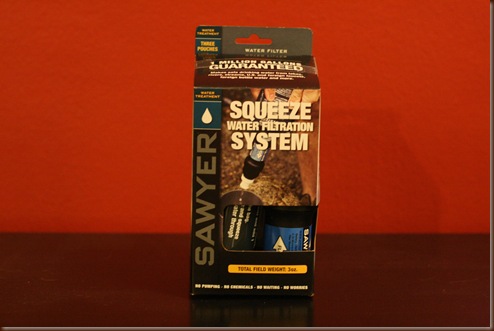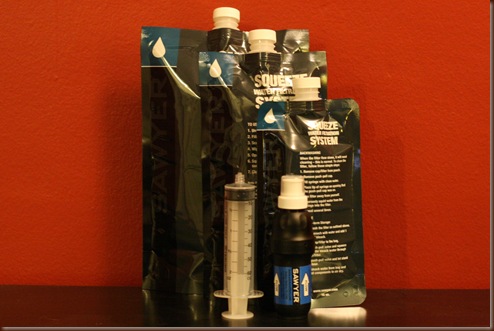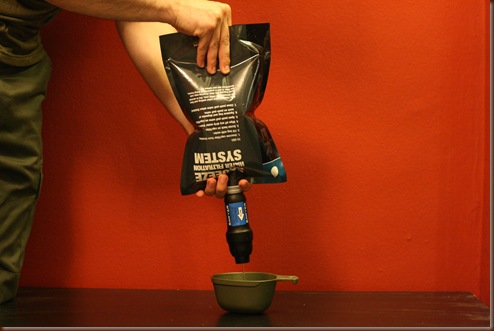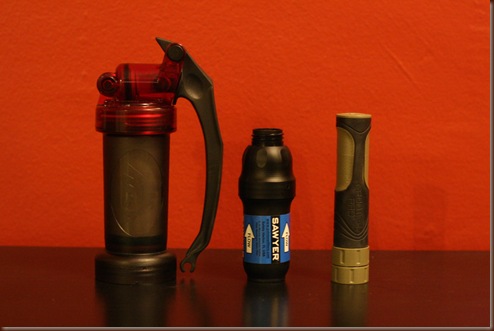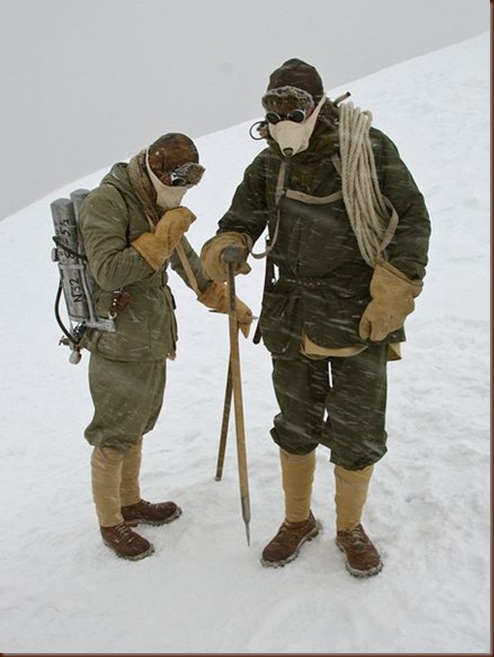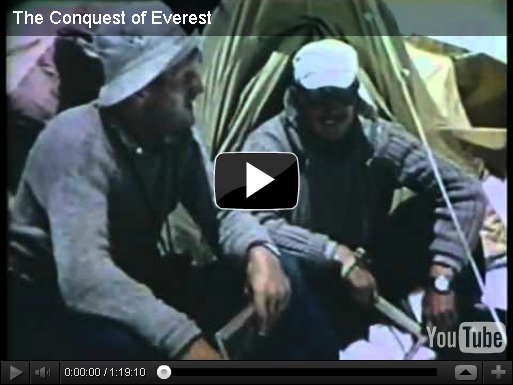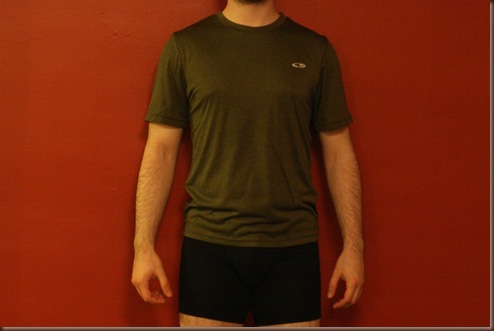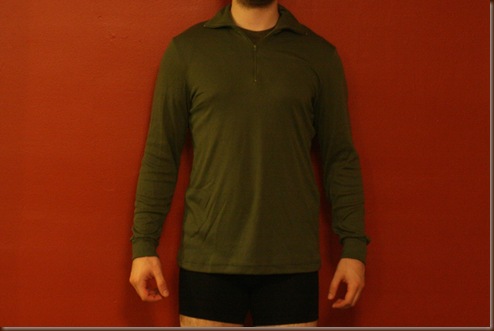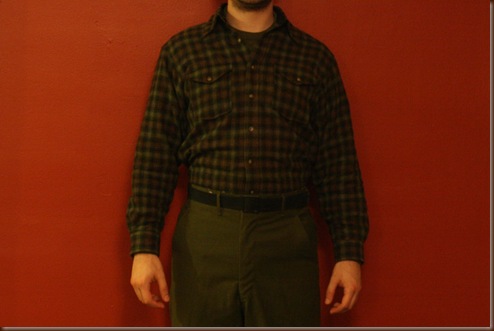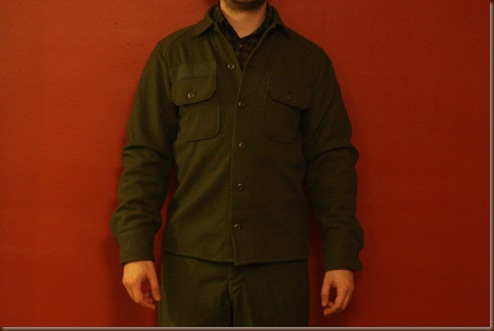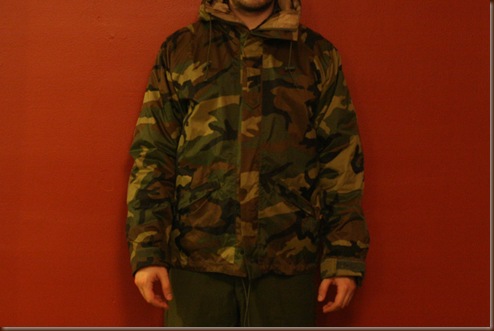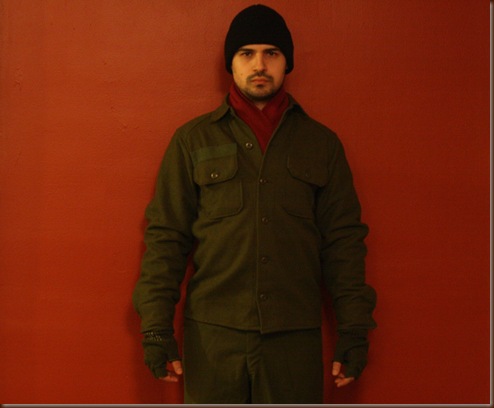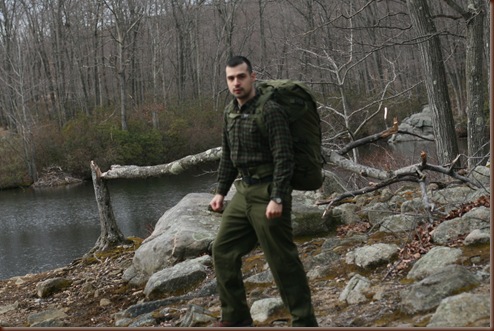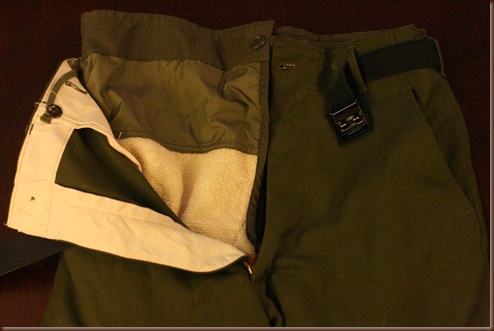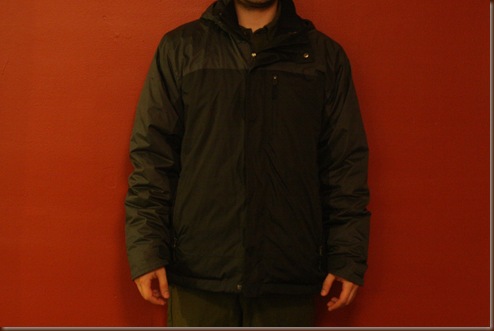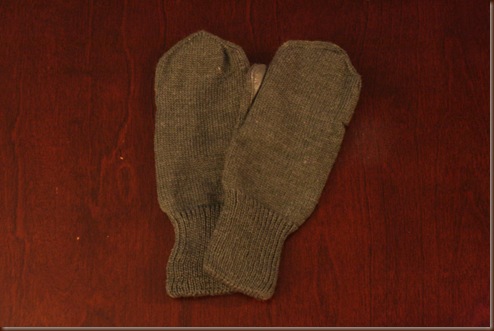As I have mentioned numerous times before, for many years now I have been using a MSR Miniworks EX as my water filter when in the woods. It is robust, easy to clean in the field, and filters well. However, it has a large downside, which is its weight. With all of the necessary accessories, it tips the scale at over a pound. I’ve been searching for a lighter option, and I think I have finally stumbled onto a good one.
As the title indicates, the solution I found is the Sawyer Squeeze Water Filter System.
The filter comes in the box you see above. Inside you have the water filter itself, three water bags, listed as being 2L, 1L, and 0.5L respectively. You also get a large syringe, which is intended to be used for back flushing the filter in the event it gets clogged. The filter itself has a screw on drinking pop-up cap, which can be removed if the filter is used by squeezing or as a gravity filter.
There are several ways to use the filter. You can attach it directly to a water bottle or hydration bladder. It has a standard fitting that will screw onto any standard size bottle opening, including a soda bottle and Platypus bags. You can then use the pop-up drinking spout to drink directly from the bottle. If you remove the drinking spout, you will see a hose attachment point, allowing you to use the filter as an inline gravity filter. Lastly, and the way I use it is as a squeeze filter. Simply fill one of the provided bags (or the platypus bag of your choosing) with dirty water, screw on the filter, and applying slight pressure to the bag, squeeze the water into your bottle.
In the picture you see the filter being used with the 2L bag. I am applying only very slight pressure. The filter will work well even without any pressure applied.
Specifications
The Sawyer Water Filter uses a hollow fiber filter, very similar to that used in the MSR Hyperflow Microfilter.
The filter element is not removable, but is rated to one million gallons of water. While I seriously doubt that the filter would last through one million gallons of water, it is stated right on the box, and I certainly do not have the means to test it.
The pore size on the filter is rated as 0.1 microns. In practical terms, this means that it can filter parasites like Cryptosporidium and Giardia, as well as bacteria. This is comparable performance to other backpacking filters such as the MSR Miniworks EX and the Katadyn Hiker Pro. It will not filter viruses as they are too small, but I am not aware of any backpacking filters that do that.
The filter is cleanable. It is the same back flushing process used in other hollow fiber filters. To do this with the Sawyer, you simply place the syringe, full with clean water at the opening where the water usually exits, and you push the water in, in effect back flushing it.
Sawyer lists the filter as weighing 3 oz. When completely wet, immediately after use, it weighs 3.5 oz. If however you take about 30 seconds to shake it in one direction, you can drive most of the water off, and bring the weight down to 3 oz. That leads me to think that when completely dry (something that is unlikely to happen with a filter without a removable element, the weight might be a slightly under 3 oz.
| Component | Weight |
| Filter | 3.0 oz |
| Pop-up Mouthpiece | 0.1 oz |
| Bottle Cap | 0.1 oz |
| Syringe | 1.1 oz |
| 2L Bottle/Bag | 1.0 oz |
| 1L Bottle/Bag | 0.7 oz |
| 0.5L Bottle/Bag | 0.5 oz |
I remember reading a review a while back, which indicated that the water bags were actually smaller than what was listed in the specification. Sawyer seems to have fixed that, as now each bag is actually slightly larger than what is listed. The 1L bag for example holds as much water as a Nalgele bottle, which is about 1.1L.
The Sawyer Squeeze Filtration System costs about $50.00.
Comparison to Other Filters
Size
In the picture you can see the MSR Miniworks EX (left), the Sawyer Squeeze Filter (middle) and the Aqua Mira Frontier Pro (right).
In terms of size, the Sawyer is much smaller than the MSR Miniworks EX. It is similar size to the Frontier Pro, being a little shorter, but thicker. Obviously both the Sawyer and the Frontier Pro need a separate water bag in order to function, unless you want to drink directly from the water source. That will add some volume, but both will still be much smaller than the MSR Miniworks EX.
Weight
For detailed weights of each Sawyer component, see the chart above. For the weight comparison here, I am using each filter with enough components to allow it to fill a water bottle. For the MSR I am using the filter and hose, for the Sawyer I am using the filter (without the cap) and the 1L bag, and for the Frontier Pro I am using the filter (without the hose attachment) and the same 1L bag.
| Filter | Weight |
| MSR Miniworks EX | 14.8 oz |
| Sawyer Squeeze Filter | 3.7 oz |
| Aqua Mira Frontier Pro | 2.6 oz |
It should be noted that as a hollow fiber filter, once you get it wet, it is very hard to get it completely dry. As such, the weight above for the sawyer is probably a bit higher than it would be if the filter was completely dry, but I think it is a more realistic measurement, as you are never likely to have it dry. This is an issue with all hollow fiber filters that do not have a removable element.
Filtering Capacity
In terms of filtering capacity, the competition here is mostly between the MSR Miniworks EX and the Sawyer Squeeze Filter. The MSR has a filter pore size of 0.2 and the Sawyer has a filter pore size of 0.1. Both of them will filter out parasites and bacteria.
The Aqua Mira Frontier Pro on the other hand falls significantly short in this category. I would personally never use it as a filter, and only have it here for comparison purposes. The Frontier Pro has a pore size of 3. That’s right, not 0.3, but 3! This will filter out most parasites and dirt, but will do nothing for smaller contaminants such as bacteria. Seeing how it’s not in the same league as the other two filters, I don’t care much how fast it can filter water.
It should be noted that none of the filters will filter out viruses. For that you need some form of chemical treatment. Viruses are easily killed by just about any chemical method in a very short period of time. Fortunately, viruses are not much of an issue in North America and Europe, so no treatment should be required. If traveling in other countries, a small bottle of chlorine bleach should take care of it.
| Filter | Pore Size | Filter Time for 1L |
| MSR Miniworks EX | 0.2 | 2 min 5 sec |
| Sawyer Squeeze Filter | 0.1 | 2 min 24 sec |
| Frontier Pro | 3 | n/a |
For the speed test I used the Sawyer with the 2L bag so I don’t risk running out of water. This however brings me to another point. The above times reflect only the speed of filtering. Just like any filter system which takes water from a bag in order to filter, the Sawyer requires additional time to fill up that bag. If you have a sufficiently deep water source, this should take no more than a few seconds. However, you might find yourself in a situation where you have to fill up the bag using your cup. That can add quite a bit of time.
Therefore, while the filtering rate of the Sawyer is not that much slower than the MSR Miniworks EX, the overall filtering time might be significantly longer based on conditions.
Maintenance
Field maintenance is an important factor for me when choosing a filter. That has always been the big appeal of the MSR Miniworks EX for me. It can be fully disassembled in the field without tools and the filter element can be removed and field cleaned.
The Aqua Mira Frontier Pro is on the other extreme in that it is not field maintainable at all. It does shave a pre-filter which can be changed, but after 50 gallons (as per specifications) you have to get a new filter.
The Sawyer Squeeze Filtration System falls somewhere in between. The filter element is not removable, but you can clean the filter by back flushing it. The only issue I have with that is the size of the syringe required for the job. I don’t exactly want to carry around a syringe the size of the filter just for cleaning purposes.
Sawyer states that their filter requires much less cleaning than a ceramic filter like the MSR Miniworks EX. In fact, they say that it requires about 20 times less cleaning. That means that for every 20 times you have to clean your MSR filter, you only have to clean the Sawyer once. I have no idea how true that is. It may not mean much if the water you are filtering is very dirty.
The Sawyer Squeeze Filter does not come with a pre-filter. I wish it did. It would make me feel much better about using a hollow fiber filter instead of a ceramic one.
One thing to keep in mind when using the filter, if you get dirty water on the outside of the bag, make sure to wipe it down before you start filtering. You don’t want it to drip down into the bottle.
Since it is hard to get the Sawyer filter completely dry, the instructions recommend that for long term storage, you should put a few drops of chlorine bleach in the water bag and squeeze it along with the water through the filter. That will prevent the growth of any bacteria or mold.
As with all filters (that I know if) you have to be careful to prevent freezing during winter. When the filter is wet and the water freezes, it expands and can damage the filter element. This is true for the Sawyer Squeeze Filter as well as for ceramic filters like the MSR Miniworks EX. An insulative cover can help a lot during winter.
Evaluation
So far the filter has performed very well for me. It is slower than the MSR, but it is not so slow, as to make it a nuisance when out in the woods.
Operation of the filter is very simple. The biggest issue is filling up the water bag, for which I use my cup. I wipe the cup down afterwards, but if that worries you, bring a different scoop.
I have not had any clogging issues so far. It would be interesting to see how long that lasts, and how effective back flushing would be in restoring the flow rate. In my experience (with the MSR Hyperflow), that was the biggest issue.
I keep the filter in a Ziploc bag to prevent any dripping after it has been used.
I have made a few modification to the filter, including a pre-filter and a back flushing mechanism. Together they bring the field weight of the filter to 4 oz. I hope to be able to go over the modifications in a post on Monday.
Overall, while operation and maintenance of the Sawyer is not as smooth and easy as that of the MSR Miniworks EX, the weight saving are significant. I have been able to cut off about a pound from my pack by making the switch. So far, all of the disadvantages have been minor enough to not be an issue, and have certainly been worth it considering the weight savings.
So far, for me, the Sawyer Squeeze Filter is the way to go. We will see how it holds up after some long term testing.
